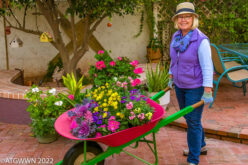
If you should tire of your 72-room Italian villa surrounded by 23 acres of formal gardens, consider donating it to your city for an art museum. This happened! In Tulsa, OK, in 1938, oil man Waite Phillips & wife Genevieve decided to move from their Italian Renaissance villa to a home in California. Tired of their Tulsa home they donated it to the city. Accepting this “house” the city opened it as The Philbrook Art Museum surrounded by its beautiful gardens in 1939. Today it continues as a great point of pride for Tulsa.

The house and museum collection is fascinating yet my interest is the gardens. The house and gardens were specifically designed to maximize the topography of the site. The gardens were inspired by Villa Lante, an Italian country estate built around 1566 north of Rome. The house and gardens are designed around a central axis with water defining the center of the design.
Standing here in the hot summer sun, you must draw a series of connections to appreciate how incredible it is to find such an ornate Italian Villa in Tulsa. The Phillips, a wealthy couple, traveled abroad and became fascinated by the architecture of 16th-century Rome. Their vision inspired a custom recreation of an Italian Villa in the middle of the United States. Plans were drawn by a Kansas City architect named Edward Delk and landscape architect Herbert Hare. Construction began in 1926 and was completed in 1927. This masterpiece remains awe-inspiring today.

From the rear balcony of the villa you enter the gardens. You look down on a large expanse of lawn with a crisscross pattern of sculpted boxwoods. Descending into the garden you must choose one of two grand staircases to reach a lower terrace. Integrated in a niche at the bottom of each staircase is antique statuary. A fountain flows from the descending water in the upper garden. You arrive at a terrace where you view the lower level of informal perennial gardens surrounding the reflecting pool.

The end of the garden is punctuated by a small white temple of love. The best view of the house is from the temple. The best view of the garden from the house is centered on the temple. The axis defines the views. Shade trees of River Birch, Black Walnut, Red Buckeye and lush lawns join the formal garden to the east garden.

The view from the summer house looks up hill through a wide green walkway leading to the main house. A fountain provides a cool spray of water. The symmetrical allee of trees along the lawn is inset with a series of shaded benches. Raised flower beds of blooming cannas and elephant ear green leaves are topped with a display of pots of flowering annuals.

Gardens of the High Renaissance style “were furnished with dramatic features and used for outdoor masques and parties. . . displays were admired and the creation of garden features to impress one’s friends became an objective.” (Garden Design, Tom Turner) There is no question this home and garden was designed to impress one’s friends.
There is so much to learn when exploring gardens of all styles and discovering their unique stories. Unlimited money combined with creative inspiration is a powerful force. Tulsa has a magnificent treasure in the Philbrook. The Phillips family left an endowment to keep the museum going and community pride continues the effort. Waite Phillips also donated the land for the famed Philmont Scout Ranch in Northern New Mexico.

